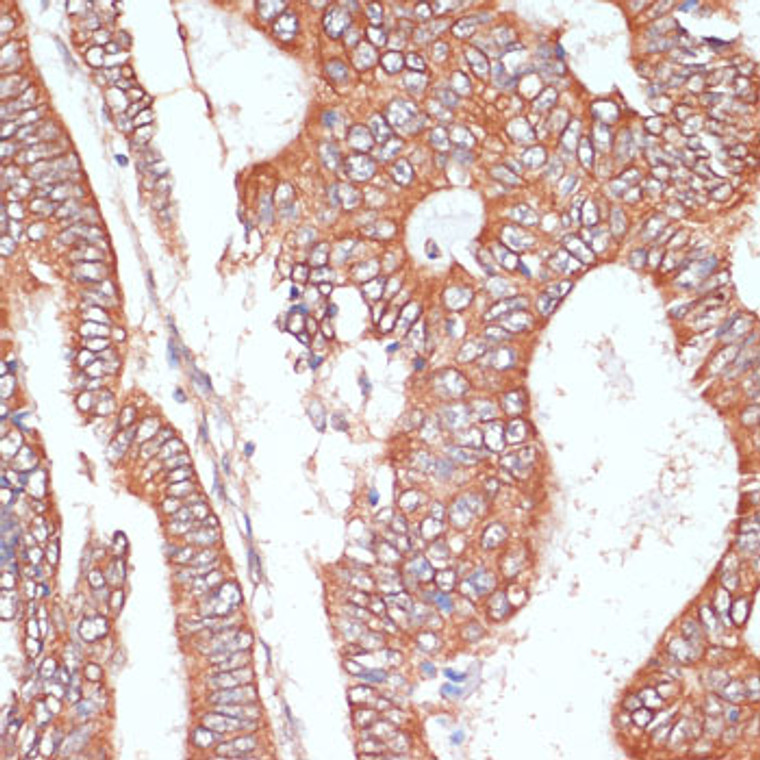| Host: |
Rabbit |
| Applications: |
WB/IHC |
| Reactivity: |
Human/Mouse/Rat |
| Note: |
STRICTLY FOR FURTHER SCIENTIFIC RESEARCH USE ONLY (RUO). MUST NOT TO BE USED IN DIAGNOSTIC OR THERAPEUTIC APPLICATIONS. |
| Short Description: |
Rabbit polyclonal antibody anti-PTPRN2 (22-242) is suitable for use in Western Blot and Immunohistochemistry research applications. |
| Clonality: |
Polyclonal |
| Conjugation: |
Unconjugated |
| Isotype: |
IgG |
| Formulation: |
PBS with 0.01% Thimerosal, 50% Glycerol, pH7.3. |
| Purification: |
Affinity purification |
| Dilution Range: |
WB 1:500-1:2000IHC-P 1:50-1:100 |
| Storage Instruction: |
Store at-20°C for up to 1 year from the date of receipt, and avoid repeat freeze-thaw cycles. |
| Gene Symbol: |
PTPRN2 |
| Gene ID: |
5799 |
| Uniprot ID: |
PTPR2_HUMAN |
| Immunogen Region: |
22-242 |
| Immunogen: |
Recombinant fusion protein containing a sequence corresponding to amino acids 22-242 of human PTPRN2 (NP_570858.2). |
| Immunogen Sequence: |
AAPSSVPRGRQLPGRLGCLL EEGLCGASEACVNDGVFGRC QKVPAMDFYRYEVSPVALQR LRVALQKLSGTGFTWQDDYT QYVMDQELADLPKTYLRRPE ASSPARPSKHSVGSERRYSR EGGAALANALRRHLPFLEAL SQAPASDVLARTHTAQDRPP AEGDDRFSESILTYVAHTSA LTYPPGSRTQLREDLLPRTL GQLQPDELSPKVDSGVDRHH L |
| Tissue Specificity | Highest levels in brain and pancreas. Lower levels in trachea, prostate, stomach and spinal cord. |
| Post Translational Modifications | Subject to proteolytic cleavage at multiple sites. |
| Function | Plays a role in vesicle-mediated secretory processes. Required for normal accumulation of secretory vesicles in hippocampus, pituitary and pancreatic islets. Required for the accumulation of normal levels of insulin-containing vesicles and preventing their degradation. Plays a role in insulin secretion in response to glucose stimuli. Required for normal accumulation of the neurotransmitters norepinephrine, dopamine and serotonin in the brain. In females, but not in males, required for normal accumulation and secretion of pituitary hormones, such as luteinizing hormone (LH) and follicle-stimulating hormone (FSH). Required to maintain normal levels of renin expression and renin release. May regulate catalytic active protein-tyrosine phosphatases such as PTPRA through dimerization. Has phosphatidylinositol phosphatase activity.the PIPase activity is involved in its ability to regulate insulin secretion. Can dephosphorylate phosphatidylinositol 4,5-biphosphate (PI(4,5)P2), phosphatidylinositol 5-phosphate and phosphatidylinositol 3-phosphate. Regulates PI(4,5)P2 level in the plasma membrane and localization of cofilin at the plasma membrane and thus is indirectly involved in regulation of actin dynamics related to cell migration and metastasis.upon hydrolyzation of PI(4,5)P2 cofilin is released from the plasma membrane and acts in the cytoplasm in severing F-actin filaments. |
| Protein Name | Receptor-Type Tyrosine-Protein Phosphatase N2R-Ptp-N2Islet Cell Autoantigen-Related ProteinIarIcaarPhogrin Cleaved Into - Ia-2beta60 |
| Database Links | Reactome: R-HSA-6798695 |
| Cellular Localisation | Cytoplasmic VesicleSecretory Vesicle MembraneSingle-Pass Type I Membrane ProteinSecretory VesicleSynaptic Vesicle MembranePredominantly Found On Dense-Core Secretory GranulesSorting To Secretory Granules In Part Is Dependent Of The N-Terminal Propeptide Domain Of The Precursor And Its Interaction With CpeTransiently Found At The Cell MembraneWhen Secretory Vesicles Fuse With The Cell Membrane To Release Their CargoIs Then Endocytosed And Recycled To Secretory Vesicles Involving Clathrin-Dependent Ap2-Mediated EndocytosisRecycled Via Stx6- But Not Tttgn1/Tgn38-Containing CompartmentsIa-2beta60: Cytoplasmic Vesicle |
| Alternative Antibody Names | Anti-Receptor-Type Tyrosine-Protein Phosphatase N2 antibodyAnti-R-Ptp-N2 antibodyAnti-Islet Cell Autoantigen-Related Protein antibodyAnti-Iar antibodyAnti-Icaar antibodyAnti-Phogrin Cleaved Into - Ia-2beta60 antibodyAnti-PTPRN2 antibodyAnti-KIAA0387 antibody |
Information sourced from Uniprot.org
12 months for antibodies. 6 months for ELISA Kits. Please see website T&Cs for further guidance











